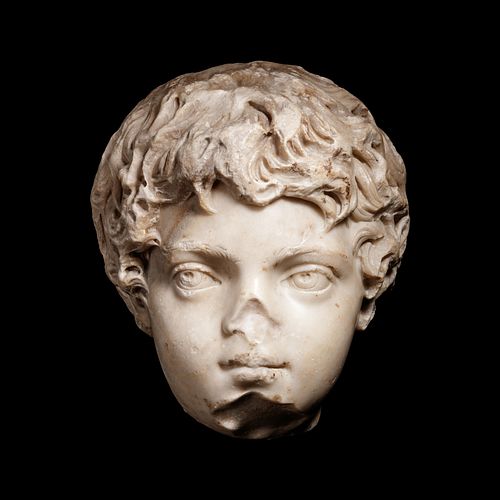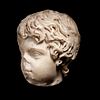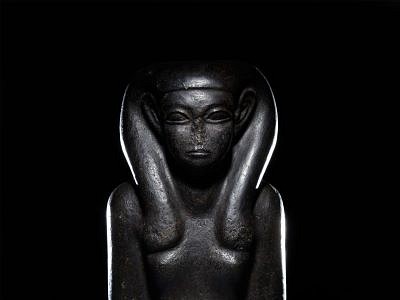A Roman Marble Portrait Head of the Young Caracalla Height 9 1/4 inches.
Lot 156
About Seller
Hindman
1338 West Lake Street
Chicago, IL 60607
United States
Recognized as the Midwest's leading fine art auctioneers, Hindman Auctioneers has built a worldwide reputation based on a full service approach to the auction business tailored to meet the individual needs of our clients. Coming from a variety of educational backgrounds, specialists bring years of e...Read more
Estimate:
$80,000 - $120,000
Absentee vs Live bid
Two ways to bid:
- Leave a max absentee bid and the platform will bid on your behalf up to your maximum bid during the live auction.
- Bid live during the auction and your bids will be submitted real-time to the auctioneer.
Bid Increments
| Price | Bid Increment |
|---|---|
| $0 | $25 |
| $500 | $50 |
| $1,000 | $100 |
| $2,000 | $250 |
| $5,000 | $500 |
| $10,000 | $1,000 |
| $20,000 | $2,500 |
| $50,000 | $5,000 |
| $100,000 | $10,000 |
About Auction
By Hindman
May 27, 2021
Set Reminder
2021-05-27 11:00:00
2021-05-27 11:00:00
America/New_York
Bidsquare
Bidsquare : Antiquities & Ancient Art
https://www.bidsquare.com/auctions/hindman-auctions/antiquities-ancient-art-6898
Hindman Bidsquare@hindmanauctions.com
Hindman Bidsquare@hindmanauctions.com
- Lot Description
A Roman Marble Portrait Head of the Young Caracalla
Circa Late 2nd Century
Height 9 1/4 inches.
Property from a Midwest Private Collection
Provenance:
de Bayser Collection, Paris.Royal Athena Galleries, New York, 2005.
Note:
This compelling portrait of the young Caracalla is a quintessential example of the Type 1 portrait type of the youthful crown prince when he was elevated to the position of Augustus at age 10 in 198 AD. Drawing upon the stylistic vocabulary of the Antonines, the Emperor Septimius Severus calculatedly promoted a sculptural program that would link his son and his own dynasty to that of his predecessor Marcus Aurelius. Only a few years before the erection of this portrait type, Septimius changed his son's official name from Lucius Septimius Bassianus to Marcus Aurelius Antoninus, linking him explicitly to the popular Antonine family. Caracalla's princely portraiture, from the beginning, reiterated this same sentiment, borrowing unequivocally from portraits of the young Marcus Aurelius as crown prince, with thick curly locks and dreamy, heavy-lidded eyes mimicking the Aurelian design. Throughout the official public name change, the young prince maintained his nickname Caracalla, brought on by the Gaulish tunic he was known to don, promoting its northern European fashion. He was also later dubbed Tarautas, after a popular but very violent gladiator who was widely feared at the time. Born in 188, Carcalla was the elder son of Septimius Severus and his second wife Julia Domna. Septimius was the first foreign-born emperor since the early second-century Emperor Hadrian, hailing from the Carthaginian city Leptis Magna in North Africa, while Julia Domna was born in the Syrian city Emesa (modern day Homs). Thus, Caracalla and his brother Geta were a unique aristocratic blend of Arab and Punic lineage. The entire family was known to favor their native eastern culture, including regional cults and rituals. Caracalla was elevated to Caesar in 196 and to Augustus in 198. He then became Septimius' joint consul in 202. Upon their father's death in 212, Caracalla and Geta were named co-Emperors. Within a year, Caracalla had his brother murdered, at which time he consolidated his power as sole emperor. He further enhanced his reputation as a ruthless soul, murdering his own wife, Plautilla, within a year of his planned fratricide. With a reign besieged by bloodshed, Caracalla himself was assassinated in 217 by a Praetorian prefect while at war in the Parthian city Carrhae in Cilicia. Caracalla's short reign is noted for the emperor's brutality and tyrannical cruelty. His most significant governing reform was the Edict of 212 which extended Roman citizenship to all free men living in the boundaries of the Roman empire. Most significantly, this expansion brought about an influx of taxes to the emperor's coffers. The infamous emperor left amongst his legacy the eponymous magnificent imperial bath complex in central Rome which was dedicated the year before his death.Height with stand 14 3/4 inches.Condition
For condition inquiries please contact jacobcoley@hindmanauctions.com. - Shipping Info
-
Please refer to https://hindmanauctions.com/shipping-packing
-
- Buyer's Premium



 EUR
EUR CAD
CAD AUD
AUD GBP
GBP MXN
MXN HKD
HKD CNY
CNY MYR
MYR SEK
SEK SGD
SGD CHF
CHF THB
THB















